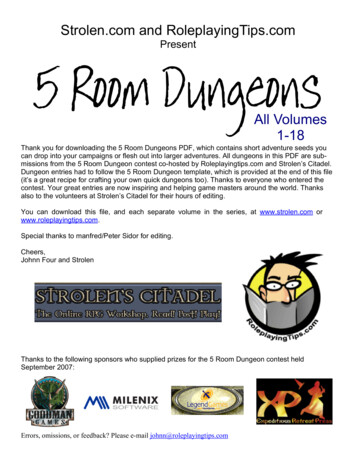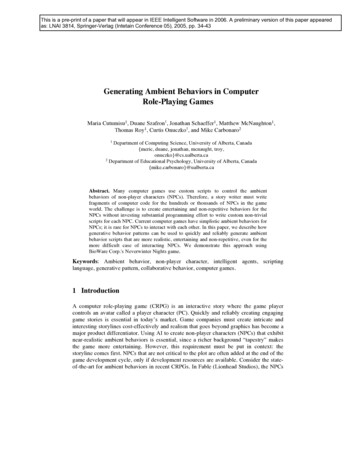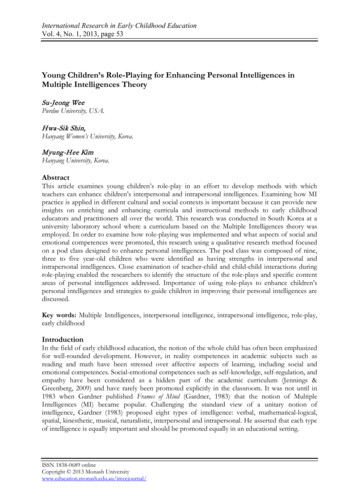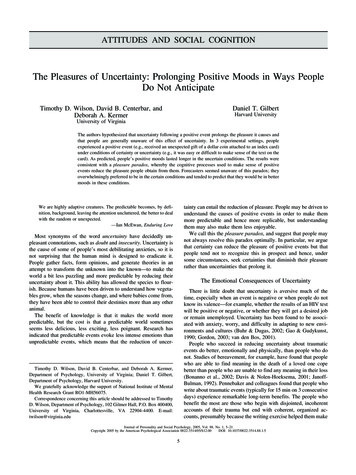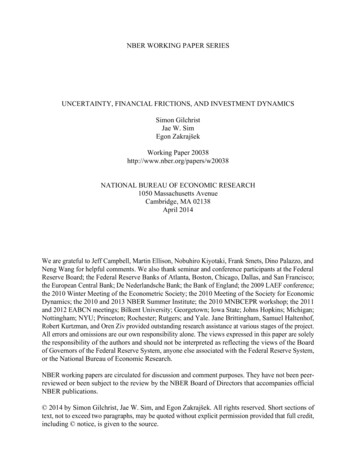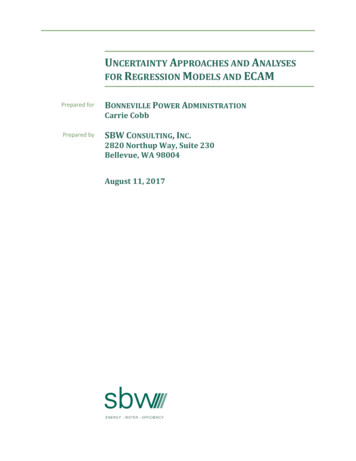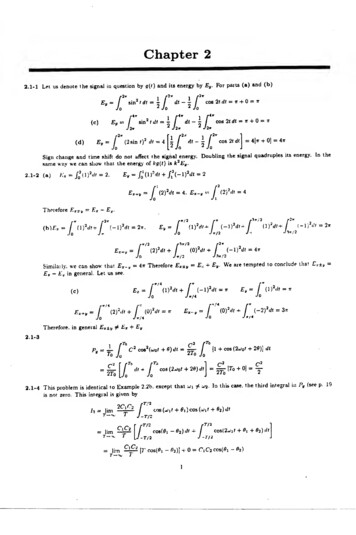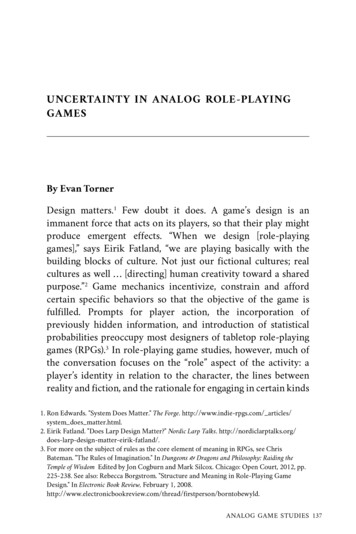
Transcription
UNCERTAINTY IN ANALOG ROLE-PLAYINGGAMESBy Evan TornerDesign matters.1 Few doubt it does. A game’s design is animmanent force that acts on its players, so that their play mightproduce emergent effects. “When we design [role-playinggames],” says Eirik Fatland, “we are playing basically with thebuilding blocks of culture. Not just our fictional cultures; realcultures as well [directing] human creativity toward a sharedpurpose.”2 Game mechanics incentivize, constrain and affordcertain specific behaviors so that the objective of the game isfulfilled. Prompts for player action, the incorporation ofpreviously hidden information, and introduction of statisticalprobabilities preoccupy most designers of tabletop role-playinggames (RPGs).3 In role-playing game studies, however, much ofthe conversation focuses on the “role” aspect of the activity: aplayer’s identity in relation to the character, the lines betweenreality and fiction, and the rationale for engaging in certain kinds1. Ron Edwards. "System Does Matter." The Forge. http://www.indie-rpgs.com/ articles/system does matter.html.2. Eirik Fatland. "Does Larp Design Matter?" Nordic Larp Talks. -eirik-fatland/.3. For more on the subject of rules as the core element of meaning in RPGs, see ChrisBateman. "The Rules of Imagination." In Dungeons & Dragons and Philosophy: Raiding theTemple of Wisdom Edited by Jon Cogburn and Mark Silcox. Chicago: Open Court, 2012, pp.225-238. See also: Rebecca Borgstrom. "Structure and Meaning in Role-Playing GameDesign." In Electronic Book Review, February 1, rstperson/borntobewyld.ANALOG GAME STUDIES 137
of play.4 If designers are working with the “building blocks ofculture,” then why aren’t we looking at how those building blocksproduce certain types of play, as opposed to other types of play?This essay on uncertainty in analog RPGs examines corevariables of RPG design that produce the very diverse sorts ofplay experiences one finds in the medium today.Some context is in order. I recently wrote a short piece abouttransparency in RPGs to highlight it as an active design element.5In that article, I drew the distinction between transparency ofexpectation – or what the player can and cannot expect from agame, which lets players make informed decisions about play– and transparency of information – or what specific plot andgame elements are revealed to the players over time. I concludedthat increasing both transparencies confers increased agency onthe player, but also increased responsibility over a game’s finaloutcome. The more you know, the more you are obliged to actsensibly on what you know. If I already know that Fiasco (2008)is a neo-noir game about ordinary criminals who create terribletrouble for themselves, then I’m not to going to play mycharacter to “win” against the scenario. If I already know thatFiona’s character is a traitor, then I can use this information toplay up my character’s loyalty to hers. This argument was madeunder the assumption that there should be more transparency inour designs, opening up lines of communication and making playmuch more egalitarian. As we know from Yevgeny Zamyatin’sdystopian novel We (1920), however, transparency in the formof glass walls to spy on one’s neighbors and absolute state4. To cite several insightful works on the topic: Mike Pohjola. “Autonomous Identities —Immersion as a Tool for Exploring, Empowering and Emancipating Identities.” In BeyondRole and Play. Edited by Markus Montola and Jaakko Stenros. Helsinki: Ropecon ry, 2004,pp. 81-96; Sarah Lynne Bowman. The Functions of Role-Playing Games. Jefferson, NC:McFarland Publishing, 2010; Todd Nicholas Fuist. “The Agentic Imagination: TabletopRole-Playing Games as a Cultural Tool.” Immersive Gameplay. Edited Evan Torner andWilliam J. White. Jefferson, NC: McFarland Publishing, 2012, pp. 108-126.5. Evan Torner. "Transparency and Safety in Role-Playing Games." WyrdCon Companion Book2013. Edited by Sarah Lynne Bowman and Aaron Vanek. Los Angeles, CA: WyrdCon, 2013,pp. 14-17.138 AARON TRAMMELL, EVAN TORNER, AND EMMA LEIGH WALDRON
surveillance could be seen as too much of a good thing.Surveillance activates our capacity to act, but it can also stifleus. This got me thinking: what should players of a game knowalready in advance, and what elements cannot (and/or shouldnot) be knowable? The border between what can be consideredknown and what cannot is certainly a “building block of culture,”as Fatland put it, and how we play with it can crucially influencethe outcome of any game design.UNCERTAINTY AND KNOWLEDGERPG design may, in fact, be creating different epistemologies thatoutline what knowledge is. An epistemology theorizes what canbe considered a fact, belief, or opinion. RPG designers aspire toassist the fluid communication of facts, ideas and expectationsduring play, but must in turn abandon the notion that they can“control” the actual playing of the game in any given way.Countless RPGs still contain language such as “the rules are notthe final word – you are,”6 or “never let the rules get in the way ofwhat makes narrative sense.”7 Whereas other epistemologies in,say, scientific inquiry or legal studies hypothesize, verify, codifylaws, and interrogate previous laws, RPG design presumes upfront that every aspect of play – including rules – is relational tothe group who plays the game.Hypotheses become impossible without sufficient fixedvariables, and even the laws/rules themselves become entirelyrelative to the group in question. Playtesting is an attempt atparing down variables to see a game in action, but this presentsan always-compromised view of a game’s general arc. If designmatters so much, why do designers often disavow the designitself? Perhaps it is to acknowledge that the simple and relationaldelineation of diegetic truths – what some call “fictionalpositioning”8 – remains the most powerful tool in the RPG6. Monte Cook. Numenera. Seattle, WA: Monte Cook Games, 2013. p. 320.7. Leonard Balsera, et al. Fate Core. Silver Spring, MD: Evil Hat Productions, 2013, p.185.ANALOG GAME STUDIES 139
medium. Most of what a designer does is determine the aspectsthat are to be known and transparent in a given game, and howthe unknown or hidden aspects reveal themselves to the players.The rest is up to the improvisational skills of a given group.Talk of transparency and knowledge begs the broader questionof the use of uncertainty in RPGs. To design any game within aculture means controlling different aspects of a game’s sociallyexperienced uncertainty. As George Elias, Richard Garfield andRobert Gutschera write: “[If] we had to pick one ingredient thatwas necessary (although not sufficient) for something to be agame, uncertainty in outcome would probably be it.”9 Becauseof that concept’s inherent “slipperiness,”10 however, few gamedesigners discuss uncertainty beyond the level of card/diceprobabilities and the use of secrets/hidden information.If what we call “culture” is based on knowledge, ignorance, andpractices that delineate the known from the unknown, then adesigner’s deliberate use of uncertainty becomes a decisivelycultural act. What varieties of uncertainty are required indifferent types of role-playing experiences, and how does RPGdesign attend to the different levels of uncertainty at work? Ifyou think about it, analog RPGs in which “anything may beattempted”11 contain such variegated and nuanced levels ofuncertainty that maybe Werner Karl Heisenberg would haveconsidered them worthy of study. At a gaming convention, forexample, organizers often have no idea who will be sitting withthem at a given role-playing game table. When rolling dice,players don’t know if their character will succeed or fail.Costumes in live-action RPGs may tear or fall apart. Sick playersmay find themselves in moods that affect their actions in the8. Vincent Baker. "Where were we.?" anyway. November 12, 2012. http://lumpley.com/index.php/anyway/thread/689.9. George Skaff Elias, Richard Garfield, and K. Robert Gutschera. Characteristics of Games.Cambridge, MA: MIT Press, 2012, p. 137.10. Elias, Garfield, and Gutschera, p. 139.11. See also Jon Peterson. Playing at the World. Stanford, CA: Unreason Press, 2012.140 AARON TRAMMELL, EVAN TORNER, AND EMMA LEIGH WALDRON
story. If after 2 hours of fiddling about, the players (andcharacters) still can’t solve the Riddle of the Sphinx, and the endof the session looms near, how should the situation be handled?Uncertainty is baked into the role-playing medium. In someinstances, we savor it – in others, we despise it.It should come as no surprise that Greg Costikyan, a formerRPG designer (Paranoia (1984), Star Wars: The Role-Playing Game(1987)), has written a book-length essay entitled Uncertainty inGames (MIT, 2013).12 The book helps us to address questionsabout uncertainty, drawing on a set of perspectives which spanthe field of game design. See, we currently have a movementin game studies called “platform studies,”13 which isolates andexamines how different platforms directly impact the aestheticexperiences created via their “software” (the games themselves).The movement has been able to use differentiation amongplatforms to draw wider conclusions about the possibilities ofhuman cultural expression in an age of media saturation. On theother hand, Costikyan succeeds at performing a classic crossplatform analysis of the games he cites, focusing on universallyshared characteristics across all games. Uncertainty in Gamespresents a concise argument about game design with numerousexamples drawn from a host of different games: board, tabletopRPG, mobile app, console, etc. So maybe it is a Procrustean act tore-assert platform specificity using his elegant model but, heck, Iwant to take a closer look at analog role-playing games: tabletop,live-action and freeform.THE MANY VARIETIES OF UNCERTAINTYCostikyan presumes that most games have multiple sources ofuncertainty, and that the best-designed games are those thatchannel these uncertainties toward the fulfillment of the game’s12. This book is part of the excellent new Playful Thinking series at MIT Press, edited by JesperJuul, Geoffrey Long and William Uricchio.13. For more information about platform studies, see http://www.platformstudies.com/.ANALOG GAME STUDIES 141
objectives. This point is important, in that adjustment of givenuncertainties in games affect what both the designers and playerscan expect from play, and how knowledge of and about the gamemight be co-constructed. If “fun is the desired exploration ofuncertainty,” as Alexandre Mandryka recently posited,14 thennew forms of knowledge – and new epistemologies – await usin these explorations as well. We can now see how uncertaintymight be used a tool to ask the straightforward question: howdoes this particular RPG work? This essay uses his language ofprocedurality to describe disparate RPGs in compatible terms.This method allows me to describe the tensions inherent inRPGs that highlight their most game-like features.Costikyan identifies eleven forms of uncertainty, each centeringon a specific question. Bear with me – we’ll need these termslater: performative uncertainty (“Will I be able to physicallyexecute this maneuver?”), solver’s uncertainty (“Can I solve thepuzzle here?”), player unpredictability (“How is my playexperience contingent on the actions of others?”), randomness(“What will fortune give me?”), analytic complexity (“Whatdecision will I make, given this complex decision tree?”), hiddeninformation(“What information is being deliberately withheld?”),narrative anticipation(“What’s going to happen next?”),development anticipation (“What new additions/releases will thepublisher make?”), schedule uncertainty(“When will I next beable to return to this game?”), uncertainty of perception(“Howcan I filter out certain data to perceive the important data?”) andsemiotic uncertainty(“What will my playing this game mean?”).Most games dovetail two different primary forms of uncertaintyto generate tension. For example, Dimitry Davidoff’s everpopular party game Werewolf (1986), also known as Mafia (1986),uses player unpredictability and hidden information to drive the14. Alexandre Mandryka. "Fun and uncertainty." Gamasutra. January 29, yka/20140129/209620/Fun and uncertainty.php.142 AARON TRAMMELL, EVAN TORNER, AND EMMA LEIGH WALDRON
game forward. We as players aren’t really interested whether ornot we’re capable of playing the game (performative uncertainty)or whether or not Davidoff will introduce a new variant of thegame while we’re playing it (development anticipation), but we aresuper-invested in A) anticipating other players’ behavior and B)judiciously hiding or figuring out who’s killing all the innocentcivilians. Without both sets of activities, Werewolf would be arather boring game.Games often appear to hold one form of uncertainty in highregard, but will then reveal through play the dovetailed forms ofuncertainty that actually drive the game. The old Sierra King’sQuest (1984-1998) adventure games for the PC were ostensiblyabout “the story” (narrative anticipation), but actually leanedheavily on solver’s uncertainty (i.e., using the right objects in theright way at the right time) and uncertainty of perception (i.e.,locating hidden objects in the game’s artwork).15 Such a move ledto the adventure genre’s eventual decline16 and rebirth throughthe “hidden object” genre.17 The Settlers of Catan (1995) boardgame is ostensibly concerned with a player’s strategy for winning(analytic complexity), whereas actual gameplay reveals an overtfocus on randomness (how the dice determine availability ofresources) and player uncertainty (how much players are willing totrade for the resources in play).Analog role-playing games prove interesting as an uncertainty15. Such critiques
RPG designer (Paranoia (1984), Star Wars: The Role-Playing Game (1987)), has written a book-length essay entitled Uncertainty in Games (MIT, 2013).12 The book helps us to address questions about uncertainty, drawing on a set of perspectives which span the field of

